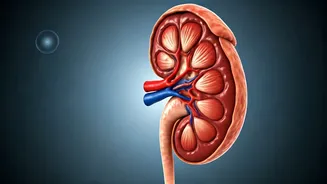The Damage Thresholds
For those with type 2 diabetes, the point at which high blood sugar starts to inflict damage isn't a single number but rather a range and the duration.
While there's no precise figure that universally triggers harm, consistent readings above certain levels elevate the risk. Generally, fasting blood sugar levels consistently above 130 mg/dL or an HbA1c (a measure of average blood sugar over 2–3 months) above 7% are cause for concern. These levels, if sustained over time, increase the likelihood of diabetes-related complications. However, individual responses can vary; some people may show signs of damage at lower levels, and others might tolerate slightly higher levels without immediate problems. The key is consistent monitoring and proactive management to keep blood sugar within a healthy target range as advised by a healthcare professional.
Vulnerable Systems Affected
Several systems in the body are particularly vulnerable to damage from elevated blood sugar. The eyes, kidneys, nerves, heart, and blood vessels are among the most susceptible. High blood sugar can damage the small blood vessels in the retina, leading to diabetic retinopathy and potential vision loss. Similarly, the kidneys' filtering units, or nephrons, can be damaged, resulting in diabetic nephropathy and kidney failure. Nerve damage, known as diabetic neuropathy, can cause pain, numbness, or tingling in the extremities and can impact the function of internal organs. Cardiovascular health is also at risk, with elevated blood sugar contributing to heart disease, strokes, and peripheral artery disease by damaging blood vessels. Over time, all these complications can significantly impair quality of life.
Eyes and Vision
Diabetic retinopathy, a frequent complication, emerges as the high glucose weakens the fine blood vessels in the retina. Initially, it might go unnoticed, but eventually, it leads to blurred vision, floaters, and possibly blindness. Regular eye checkups are essential for early detection. The longer the duration of diabetes and poorly controlled blood sugar, the higher the risk. Other conditions like macular edema, where fluid accumulates in the macula, can further compromise vision. Prompt intervention, like laser treatments or injections, can often slow down progression. Careful management of blood sugar, blood pressure, and cholesterol can reduce the risk. Early intervention plays a critical role in preserving sight.
Kidney Health Risks
Diabetic nephropathy arises when high blood sugar damages the small blood vessels in the kidneys, leading to impaired kidney function. Early signs might include protein in urine. This damage progresses slowly, potentially leading to kidney failure. Monitoring kidney function through regular blood and urine tests is essential for early detection. Maintaining blood sugar, blood pressure, and cholesterol levels within recommended ranges is crucial. Lifestyle adjustments, such as dietary modifications and, in severe cases, dialysis or kidney transplant may be necessary. Regular checkups and prompt treatment can significantly slow progression and protect kidney health.
Nerve Damage Concerns
Diabetic neuropathy occurs when high blood sugar damages the nerves, affecting sensation and function. It manifests in various ways, like pain, numbness, and tingling, often in the feet and hands. The damage can also affect internal organs, leading to digestive issues, heart problems, and sexual dysfunction. Controlling blood sugar, managing blood pressure, and adopting a healthy lifestyle are essential steps in prevention. Medications can help alleviate the symptoms, but managing the underlying causes remains critical. Prompt medical attention and consistent care can help prevent severe complications and improve quality of life.
Heart and Vessels
Elevated blood sugar significantly increases the risk of cardiovascular disease. The damage to blood vessels caused by persistent high glucose levels accelerates the formation of plaque, leading to heart attacks and strokes. Controlling blood sugar is a central aspect of prevention, along with managing blood pressure and cholesterol levels. Lifestyle changes, such as a balanced diet, regular exercise, and avoiding smoking, are crucial. Regular checkups and early intervention are essential for protecting heart health. Proactive measures can mitigate these risks and improve the overall well-being of individuals with diabetes.
Minimize Your Risk
Several strategies are pivotal in minimizing the risks associated with high blood sugar. First and foremost, regular blood sugar monitoring is crucial for understanding how food, exercise, and medications impact glucose levels. Following a balanced diet, focused on portion control, whole grains, fruits, vegetables, and lean proteins, helps maintain stable blood sugar levels. Regular physical activity, such as brisk walking or other forms of exercise, improves insulin sensitivity. Additionally, taking prescribed medications as directed by your healthcare provider plays a vital role in managing blood sugar. Furthermore, regular checkups with healthcare providers are important for monitoring overall health and addressing complications early. These proactive steps can significantly reduce the potential for long-term health issues.











